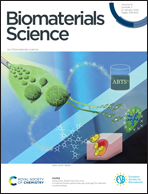Engineering of protein crystals for use as solid biomaterials
Abstract
Protein crystals have attracted a great deal of attention as solid biomaterials because they have porous structures created by regular assemblies of proteins. The lattice structures of protein crystals are controlled by designing molecular interfacial interactions via covalent bonds and non-covalent bonds. Protein crystals have been functionalized as templates to immobilize foreign molecules such as metal nanoparticles, metal complexes, and proteins. These hybrid crystals are used as functional materials for catalytic reactions and structural analysis. Furthermore, in-cell protein crystals have been studied extensively, providing progress in rapid protein crystallization and crystallography. This review highlights recent advances in crystal engineering for protein crystallization and generation of solid functional materials both in vitro and within cells.



 Please wait while we load your content...
Please wait while we load your content...